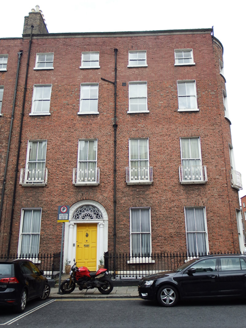Survey Data
Reg No
50100304
Rating
Regional
Categories of Special Interest
Architectural, Artistic
Original Use
House
In Use As
Office
Date
1775 - 1795
Coordinates
316341, 233338
Date Recorded
26/07/2016
Date Updated
--/--/--
Description
Corner-sited three-bay four-storey former house over basement, built c. 1785 as pair with No. 10 to west, having two-bay bowed east elevation. Now in use as offices. Pitched roof, hipped to east end, behind red brick parapet with moulded granite coping over rendered platband, buff brick chimneystack over rendered base to west party wall with yellow clay pots, parapet gutters, and cast-iron hopper and downpipe. Flemish bond red brick walling, refaced above second floor window heads, over painted masonry plinth course above painted rendered walling to basement. Square-headed window openings, diminishing in height to upper floors, with brick voussoirs, painted granite sills and painted rendered reveals. Two-over-two pane timber sliding sash windows with ogee horns, frames and glass curved to bowed east elevation, and replacement uPVC to basement with iron grilles. Decorative cast-iron balconettes to first floor. Round-headed door opening with painted rendered masonry doorcase with Ionic columns having acanthus flower-enriched capitals, plain entablature, ornate leaded fanlight with scalloped archivolt, and ten-panel timber door with brass furniture. Granite entrance platform with two steps to street, flanked by spear-headed cast-iron railings on painted granite plinth, extending east to enclose basement area.
Appraisal
Forming a pair with No. 10 to the west, No. 9 was built c. 1785 by the stuccodore and master builder Charles Thorp, who was responsible for much of the north side of the street, but invested most heavily in Nos. 9 and 10. Characterized by finely balanced proportions and graded fenestration, the enriched Ionic doorcase and the elaborate fanlight set in a scalloped archivolt, add a decorative element to the otherwise restrained façade, which is highly representative of late eighteenth-century Dublin townhouses. Casey (2005) notes that the interior features Thorp's rich neo-Classical plasterwork. Thorp was a significant figure within the creation of neo-Classical interiors in Dublin and key examples of his work include the Blue Coat School and Royal Exchange. Located on a prominent corner site, No. 9 is a worthy example of its type, constituting an important component of the Georgian character of Hume Street and Ely Place, and contributing to the wider architectural heritage of south Dublin, while also constituting an important record of Thorp's skill as a stuccodore.



















